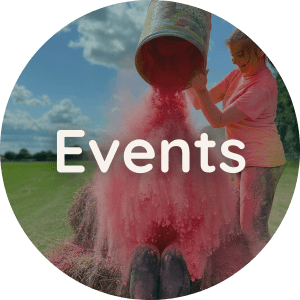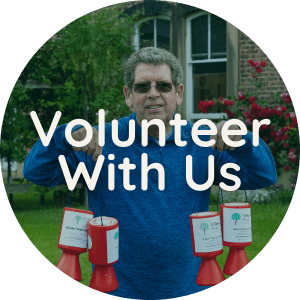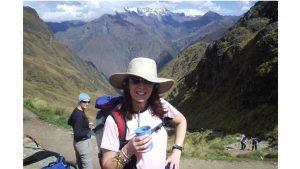Described as ‘a little haven tucked away’ on Woodland Road in Darlington, St Teresa’s Hospice is dedicated to providing care and enhancing the quality of life of those living with illnesses, as well as their relatives and loved ones.
To gain a better understanding of what could happen at the end of our lives, and to understand the lives of those who will care for us, Young Reporter Olivia Smith spoke with Karen Shield, a healthcare assistant who works at the hospice, about her role and what inspired her to work in this field.
What do you do on a day-to-day basis?
The first thing we do is handover, where all the details about each patient’s care are passed on from one shift to the next, ensuring that everybody knows what tasks must be completed. Then, we will check on each patient, but if they are still asleep, we will leave them to wake up when they are ready whilst also making sure they are comfortable.
Once they wake, we greet them with a warm good morning and assist them to get ready for breakfast if the patient is eating. Breakfast varies from a small snack to cooked meal; everything is down to the patient’s individual preference.
After breakfast, we will provide the patients with any personal hygiene requirements, for example a bath, a shower or a bed bath. Patients can ask for this at any time of the day, and some describe it to be like a pamper session, as we often play music, wash and blow-dry their hair, and apply different creams.
We spend a lot of time on this, which helps to get to know each patient and it helps them to feel at ease. Throughout the day, we make the patients feel relaxed by doing regular comfort rounds, where we assure that the patients are in a comfortable position and we may help them to move.
We check if they need anything to drink or any mouth care, we help them feel the best they can and make sure they aren’t in pain, and anything else they may require. Patients may have visitors throughout the day from their loved ones to make the hospice feel like home.
Patients also enjoy walks around the garden to soak in the wildlife – we do our best to offer them comfort and reassurance as they approach the end of their life. We document each patient’s care throughout the day, noting any changes to their care or medication.
At the end of the day, handover sheets are completed to be passed on to the following shift, allowing good continuity of care for the patients.
Every day is different but no matter what, the patients always come first. Some patients may enjoy having a laugh and a joke with staff, whereas others may not, and that is totally respected by everybody.
How do you provide support to the families and loved ones of patients?
The staff at the hospice are like one big family, and anyone who comes into the hospice, whether it’s a patient or their loved ones, becomes part of this family.
It is important to foster a welcoming atmosphere so people don’t feel afraid, because they have no reason to be. We have a lot of patients and families who have said just stepping through the doors gives them that sense of a safe, secure and warm environment.
It is hard for many families who have been caring for their loved ones for so long to pass the role on to someone else, but it gives the families an opportunity to enjoy precious time with their loved ones, rather than taking on the role of a carer.
We give the families of patients emotional support, allowing them time to express their feelings and we listen to their worries and concerns with empathy.
Some of the support we offer includes a referral to our family support team, bereavement care, complimentary therapies, carer support groups, and we offer specialised support for children too.
How do you create a calm environment at the hospice?
Each patient has their own room with mood lighting and an en-suite bathroom, offering a homely environment with an outlook onto beautiful gardens and colourful flowers and trees.
We often can see foxes and and squirrels playing, we can listen to the owls and see the various birds feeding from the bird feeders. The wildlife makes the hospice feel like another world, and it is often one of the first things patients and families notice and talk about.
It is a huge misconception that people only come into a hospice for end-of-life care, or only for a cancer diagnosis, however we also admit so many patients for other causes, such as symptom management and any life-limiting illness, who are able to go back home again.
Some of these patients come in and feel so welcomed and well cared for that they then choose the hospice as their preferred place of death when the time is right.
We spend a lot of time with patients who are in the final days of their life, to make sure they are settled and comfortable, and we allow families to spend quality time with them as well.
How did you get into this role?
Although I had worked in healthcare for over twenty years, working in a hospice had never crossed my mind until a work colleague who was working at the hospice asked if I would ever consider working there.
My response was that I didn’t think I could; I did not think it was for me, and although I have dealt with people dying, I wasn’t sure I could cope with people dying on a regular basis and questioned whether I would know the best way to support families, whether I would know the right things to say to them, and whether I would be able to comfort them.
I also questioned whether I would be too emotional for the role myself, I did not feel confident I could do it, but she reassured me I could, so I joined the hospice bank staff alongside continuing my job at the time. I worked shifts for Hospice at Home, Rapid Response team and the Inpatient Unit.
From early on, I could see the difference the whole hospice was making for patients and their families, however for me it was the Inpatient Unit that started to make me think about working there as the quality of care was easy to see. It made me realise that this is the care people deserve at the end of their lives and I wanted to be part of this. When a vacancy came up, I decided to apply, and since I got the job, I haven’t looked back.
Over the twelve years I have worked here, I have met some truly inspirational people and, although days can be really difficult and full of mixed emotions, I feel honoured and privileged to work here.















